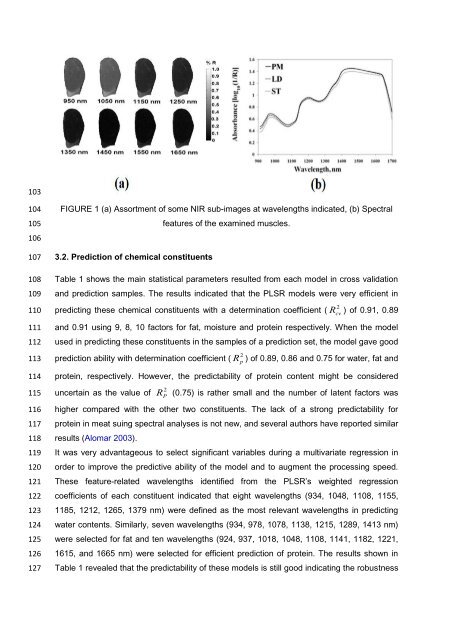Prediction of beef chemical composition by NIR Hyperspectral ... - ATB
Prediction of beef chemical composition by NIR Hyperspectral ... - ATB
Prediction of beef chemical composition by NIR Hyperspectral ... - ATB
You also want an ePaper? Increase the reach of your titles
YUMPU automatically turns print PDFs into web optimized ePapers that Google loves.
103104105106107108109110111112113114115116117118119120121122123124125126127FIGURE 1 (a) Assortment <strong>of</strong> some <strong>NIR</strong> sub-images at wavelengths indicated, (b) Spectral3.2. <strong>Prediction</strong> <strong>of</strong> <strong>chemical</strong> constituentsfeatures <strong>of</strong> the examined muscles.Table 1 shows the main statistical parameters resulted from each model in cross validationand prediction samples. The results indicated that the PLSR models were very efficient inpredicting these <strong>chemical</strong> constituents with a determination coefficient (2Rcv) <strong>of</strong> 0.91, 0.89and 0.91 using 9, 8, 10 factors for fat, moisture and protein respectively. When the modelused in predicting these constituents in the samples <strong>of</strong> a prediction set, the model gave goodprediction ability with determination coefficient (2Rp) <strong>of</strong> 0.89, 0.86 and 0.75 for water, fat andprotein, respectively. However, the predictability <strong>of</strong> protein content might be considereduncertain as the value <strong>of</strong>2RP(0.75) is rather small and the number <strong>of</strong> latent factors washigher compared with the other two constituents. The lack <strong>of</strong> a strong predictability forprotein in meat suing spectral analyses is not new, and several authors have reported similarresults (Alomar 2003).It was very advantageous to select significant variables during a multivariate regression inorder to improve the predictive ability <strong>of</strong> the model and to augment the processing speed.These feature-related wavelengths identified from the PLSR’s weighted regressioncoefficients <strong>of</strong> each constituent indicated that eight wavelengths (934, 1048, 1108, 1155,1185, 1212, 1265, 1379 nm) were defined as the most relevant wavelengths in predictingwater contents. Similarly, seven wavelengths (934, 978, 1078, 1138, 1215, 1289, 1413 nm)were selected for fat and ten wavelengths (924, 937, 1018, 1048, 1108, 1141, 1182, 1221,1615, and 1665 nm) were selected for efficient prediction <strong>of</strong> protein. The results shown inTable 1 revealed that the predictability <strong>of</strong> these models is still good indicating the robustness
















